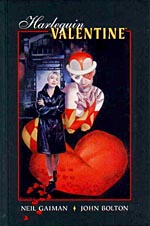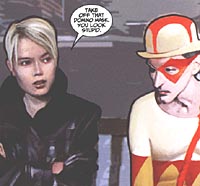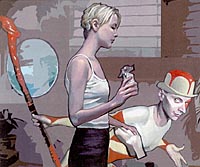
 Writer: Neil Gaiman
Writer: Neil Gaiman
Artist: John Bolton
Letterer: Richard Starkings
Price: $10.95
Publisher: Dark Horse Comics
ISBN: 1-56971-620-X
My fiancée is a romantic person. She's into flowers and shiny things and, if it weren't for the excessive number of smoke detectors at her place, she'd love me to cook her a candle-lit dinner once in a while. (I'm studying: I can hardly be expected to lavish her with a romantic dinner out and support a comic habit, now can I?)
So last Valentine's Day I did just that. Flowers and a simple pasta dish. A nice bottle of wine. No candles.
My fiancée has a knack for surprising me, so when she handed me the flat, thin present, I was taken aback, figuring it was a book. No surprises there, I like books.
But then I opened the present, and my jaw dropped. She had given me a copy of HARLEQUIN VALENTINE. OK, getting me a book was sure to go over well, but this was different. This was the one Gaiman book I had passed on, thinking I'd pick it up later in softcover. I'd mentioned this in passing and she'd remembered, and then gone to the effort of visiting the friendly folk at my local comic shop and ordering a copy for me. It might not sound like much, but for a book snob like me, it meant a lot. It showed me how well she knew me.
 If she didn't already have it, I would've pinned my heart to her front door that very night for her to have her way with. This is how HARLEQUIN VALENTINE starts: The piebald trickster pinning his heart to his one true love's front door.
If she didn't already have it, I would've pinned my heart to her front door that very night for her to have her way with. This is how HARLEQUIN VALENTINE starts: The piebald trickster pinning his heart to his one true love's front door.
Like much of Gaiman's work, HARLEQUIN VALENTINE is a retelling of an old story. This time around it's the story of Harlequin and Columbine, from the 16th Century Italian Commedia dell'arte (and later, as Gaiman informs us in a nice little essay, in French vaudeville and the English Harlequinade). An old story, but as with STARDUST and MR PUNCH (of which the English version of Harlequin was a contemporary), he brings a modern outlook to it.
In the Harlequinade, both Harlequin, with his walking stick and domino mask, and the white-faced Pierrot vie for the attentions of beautiful Columbine. Harlequin plays his tricks, for which Pierrot is blamed and punished. And, as Harlequin is the hero of our little pantomime, he comes out on top.
HARLEQUIN VALENTINE, being a Neil Gaiman short story, follows the same fairy-tale/myth-in-a-modern-setting idea with which he made his name in SANDMAN. Most of the cast of the Harlequinade, in all its forms, are here, with a few twists.
 Harlequin is still the same old Harlequin, the trickster, the Puck, the Willo the Wisp, chasing after his Columbine, a former lab assistant named Missy. He's pinned his heart to her door, as he has with all the Columbines before Missy. But Missy, being a modern girl, has unpinned the heart, placed it in a sandwich bag and taken it to her former workplace, where the coroner tells her, yep, it's a heart.
Harlequin is still the same old Harlequin, the trickster, the Puck, the Willo the Wisp, chasing after his Columbine, a former lab assistant named Missy. He's pinned his heart to her door, as he has with all the Columbines before Missy. But Missy, being a modern girl, has unpinned the heart, placed it in a sandwich bag and taken it to her former workplace, where the coroner tells her, yep, it's a heart.
Harlequin wonders what she'll do with it. Others have played with his heart, toyed with it, even kissed it and slept with it. What will Missy do? As it turns out, what she does is what Harlequin least expects...
Illustrating all this is one of Gaiman's finest collaborators, John Bolton, who painted the first part of the original BOOKS OF MAGIC. Here Bolton uses a technique that differs from his usual style. While he has always been quite photo-realistic, here he utilises painting, photography and computers in his art.
This takes Bolton's already beautifully surreal art to a new level. The figures, especially the red, yellow and white Harlequin, vividly stand out from the background, which is made up of flat, muted colours; not much detail, but just enough. It gives it a strange Andy Warhol feel, and with the characters forming such a strong visual focus, Bolton is following the idea that the characters are just actors on a stage, performing their role in the Commedia dell'arte.
The book also contains the brief, "Notes on a Harlequinade" essay, which sheds some light on the history of Harlequin and his companions, which interested me as the only exposure I'd had to the idea of the Harlequinade before I read this was THE INVISIBLES. And it ends with a completely surreal "biography" of John Bolton, written by Gaiman, involving a red gas mask and harking back to the old bio pages of some of the SANDMAN collections, making it a little story in itself.
While HARLEQUIN VALENTINE isn't Gaiman's best work, it's a sweet little story of eternal love, and how it can get you into deep shit - a sentiment utterly appropriate for this time of year.

This article is Ideological Freeware. The author grants permission for its reproduction and redistribution by private individuals on condition that the author and source of the article are clearly shown, no charge is made, and the whole article is reproduced intact, including this notice.


